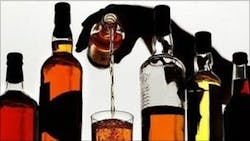Near-infrared spectroscopy detects counterfeit whisky
Fife, Scotland--Research recently published in Optics Express from the University of St Andrews claims that the researchers can determine a whisky's brand, age, and cask by using a near-infrared spectroscopy based lab-on-a-chip technique using a sample no bigger than a teardrop. Counterfeiting is a major problem for the drinks industry, which seeks new methods of detection.
The whisky sample is first illuminated by light using one optical fiber and collected by another. The method exploits both the fluorescence of whisky and the scattering of light and shift in energy when it interacts with molecules, known as its Raman signature. The technique can determine if the amount of alcohol contained in the sample is at least 40%—the mark of genuine whisky.
"We can not only gather information about the alcohol content, but also the colour and texture," said Praveen Ashok from the University of St Andrews. "These are dictated by the manufacturing process, which of course influences greatly the type of whisky people enjoy."
Professor Dholakia said, "It is amazing to think that the technology we are developing for biomedical analysis can also be used to help us enjoy a wee dram and with the minimum of waste."
SOURCE: BBC News; www.bbc.co.uk/news/uk-scotland-edinburgh-east-fife-15520904
